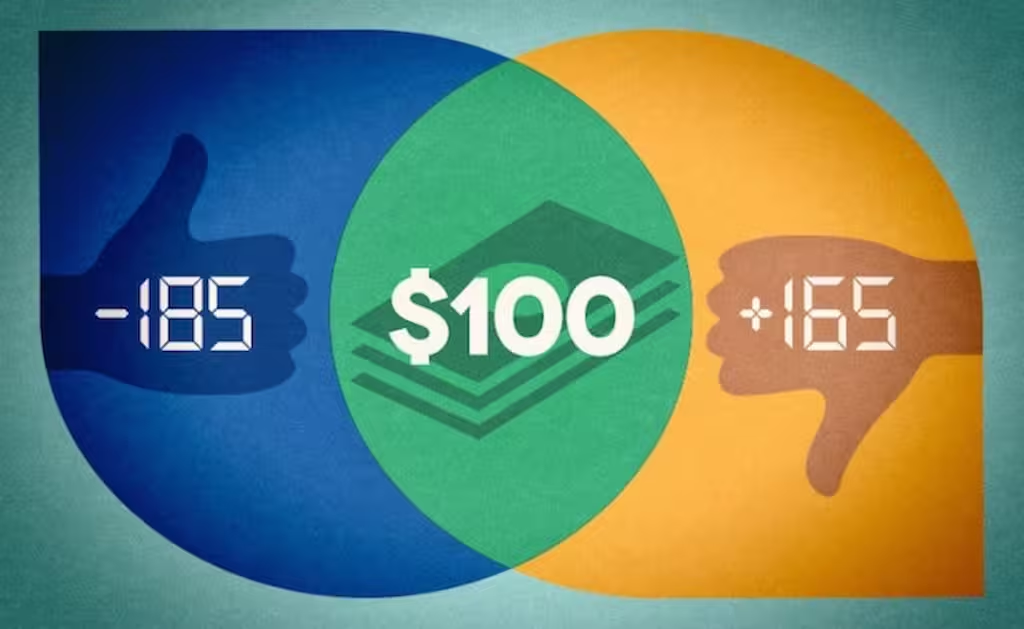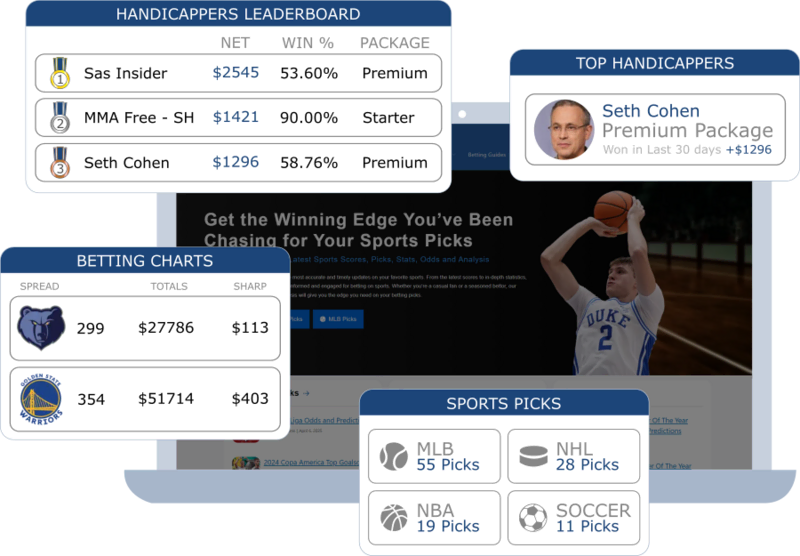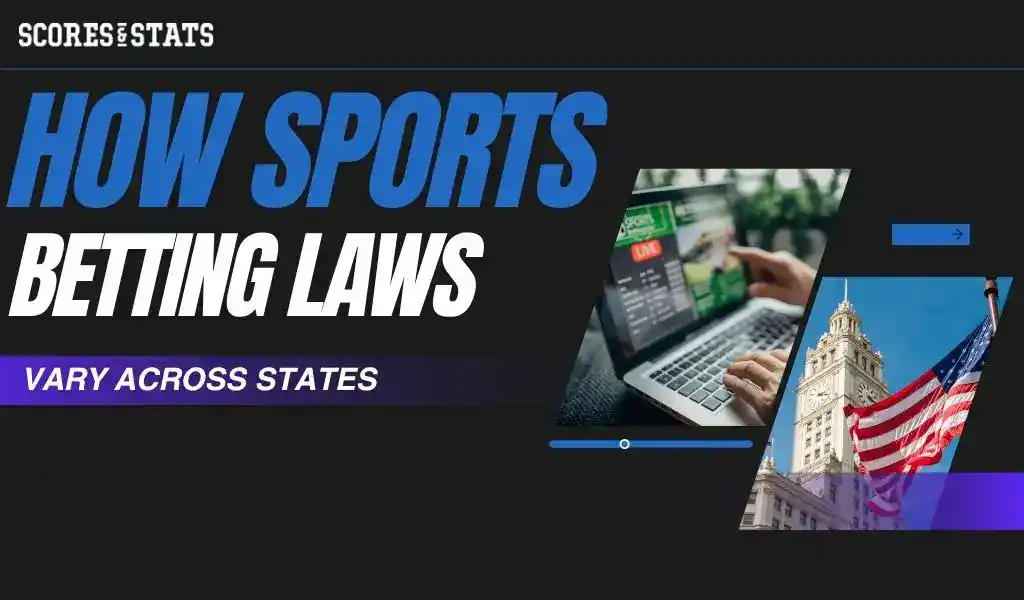In the vast world of sports betting, the money line stands out as one of the most straightforward and widely embraced forms. In essence, it encapsulates the essence of simplicity by allowing enthusiasts to wager on a team or player without the details of or involvement of point spreads. Whether you’re envisioning a triumphant football game or predicting the outcome of a riveting tennis match, money-line betting provides a direct path to excitement.
Found ubiquitously in the offerings of sportsbooks, moneyline bets grace every contest, spanning the realms of NFL, NBA, NHL, MLB, UFC, soccer, tennis, and virtually every other imaginable sport. While its popularity resonates across various athletic domains, it finds a particular niche in the NHL and MLB in the United States. Here, where games often unfold with lower scores, the allure of money-line betting shines, making it a preferred choice over spread betting.
The distinctive feature of moneyline betting lies in its emphasis on choosing the outright winner between two teams or players. The odds assigned to each opponent reflect their likelihood of securing victory. For instance, in a matchup between the powerhouse San Francisco 49ers and the Arizona Cardinals, the odds for the 49ers winning would be considerably lower, given their formidable roster boasting stars like McCaffrey, Kittle, Samuel, Aiyuk, Bosa, and Warner. Conversely, a successful moneyline bet on the Cardinals would yield a higher return, as they are perceived as the underdogs with a less probable chance of emerging victorious.
This article delves into the nuances of moneyline betting, unraveling its simplicity and exploring the strategic considerations that underpin this popular form of sports wagering. Whether you’re a seasoned bettor or a newcomer to the sports betting arena, understanding the ins and outs of moneyline betting is essential for making informed and potentially lucrative choices. So, let’s embark on a journey to demystify the world of moneyline betting and uncover the secrets behind predicting winners in the exhilarating realm of sports.
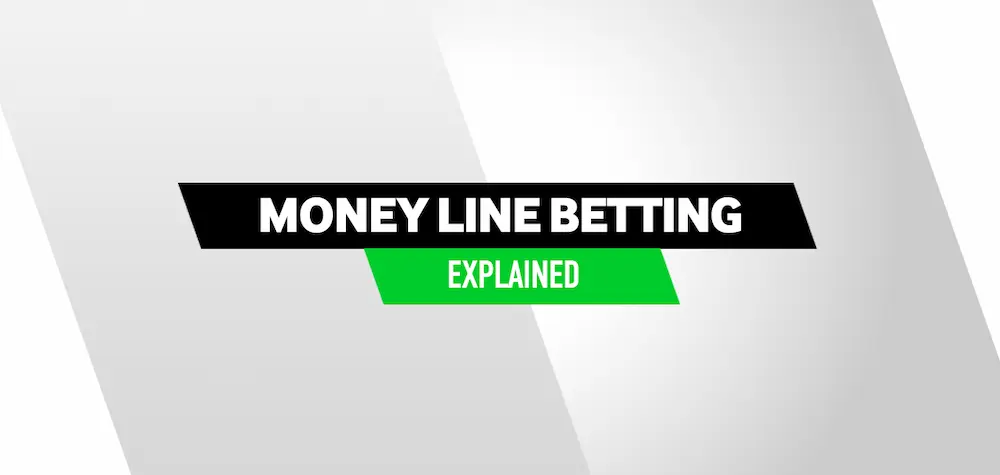
Understanding Moneyline in Betting
What is Moneyline in Betting? Moneyline betting is a straightforward and widely embraced form of sports wagering that hinges on predicting the outright winner of a particular game or event. In contrast to point-spread betting, where underdogs receive a handicap to level the playing field, moneyline betting is solely dependent on the outcome. Bettors simply choose the team or athlete they believe will emerge victorious and place their wager accordingly.
The odds in moneyline betting are represented by plus or minus signs, signifying the likelihood of each team’s success. A plus sign designates the underdog, while a minus sign indicates the favorite. Understanding these signs is crucial, as they not only convey the team’s status but also provide insight into potential payouts.
Who are the Favorites?
Favorites in moneyline betting are denoted by negative numbers, representing the amount one must bet to win $100. For instance, if a team’s moneyline odds are -150, a bettor would need to stake $150 to secure a $100 profit should that team win. The size of the negative number indicates the level of favoritism, with larger values suggesting a more heavily favored team and lower potential winnings.
Who are the Underdogs?
On the flip side, underdogs are portrayed with positive numbers, indicating the potential profit for a $100 bet. If a team’s moneyline odds are +200, a successful $100 bet would yield a $200 profit, showcasing the underdog’s perceived lower likelihood of winning. Larger positive numbers signify greater underdog status and higher potential payouts.
Pick ‘em or Even
In situations where two teams or athletes are evenly matched, creating a scenario known as a “pick ’em,” the moneyline odds for both parties are identical. This is often represented by the term “Even” or “even money.” In pick ’em situations, bettors must simply choose the team or athlete they believe will win, without the influence of handicaps or point spreads. The payout for a winning bet in such cases is usually even money, ensuring the bettor receives an amount equal to their initial wager.
While pick ’em games add an element of excitement due to their closely contested nature, it’s essential to note that even in these scenarios, ties or pushes can occur. A tie results in a draw or a margin of victory precisely matching the point spread, leading to a refund of the original wager. In navigating the dynamic landscape of moneyline betting, understanding the odds and the status of each team is key for both novice and seasoned bettors alike.
How to Place a Moneyline Bet?
Placing a money line bet is a straightforward process that opens up a world of possibilities for sports enthusiasts seeking a direct route to wagering excitement. Virtually every sportsbook provides moneyline markets for an extensive range of matchups, ensuring a plethora of options for eager bettors. However, it’s wise to explore different sportsbooks, as odds can vary from one platform to another. A favorite might present itself at -150 in one book and -160 in another, while an underdog could be listed at +200 in one location and +195 elsewhere.
Timing and strategy play pivotal roles in determining when the money line is the superior option compared to the point spread. For instance, if an underdog is given a mere 1.5-point advantage on the point spread, opting for the money line could prove more lucrative, offering a larger payout. Regardless of the point spread, if confidence in an underdog’s outright victory is high, selecting the money line becomes an attractive proposition for maximizing returns.
Conversely, when there’s an unwavering confidence in a favorite’s outright triumph, coupled with apprehensions about them covering the spread, the moneyline emerges as an appealing alternative. Whatever the preferred play, diligent research on team and player news, historical head-to-head data, and other relevant factors remain crucial for making well-informed decisions in this dynamic market.
To embark on the journey of making a money line bet, follow these simple steps:
- Choose a sportsbook: Select a reputable sports betting site that offers moneyline betting on the specific sport and event of interest. With numerous online sportsbooks available, a curated list of the best options can simplify the decision-making process.
- Select the game or event: Identify the matchup you wish to bet on and locate the money line odds for each team, athlete, or outcome involved.
- Choose your bet: Decide on the team, athlete, or outcome you want to bet on and determine the amount of your wager. Moneyline betting is a direct choice – predicting the winner of the game or event.
- Place your bet: Enter the chosen wager amount and confirm the bet. Online bettors can follow the platform’s prompts to submit the bet, while those betting in person can hand their bet slip to the cashier along with the payment.
- Wait for the outcome: Once the game or event concludes, check the results to see if your bet was successful. A winning bet will result in a payout based on the moneyline odds associated with the chosen team or athlete. In cases of a voided bet or a push, bettors can expect a deposit equivalent to their original wager.
By following these steps, sports enthusiasts can engage in the thrill of moneyline betting, testing their predictions against the unpredictable outcomes of their chosen games or events.
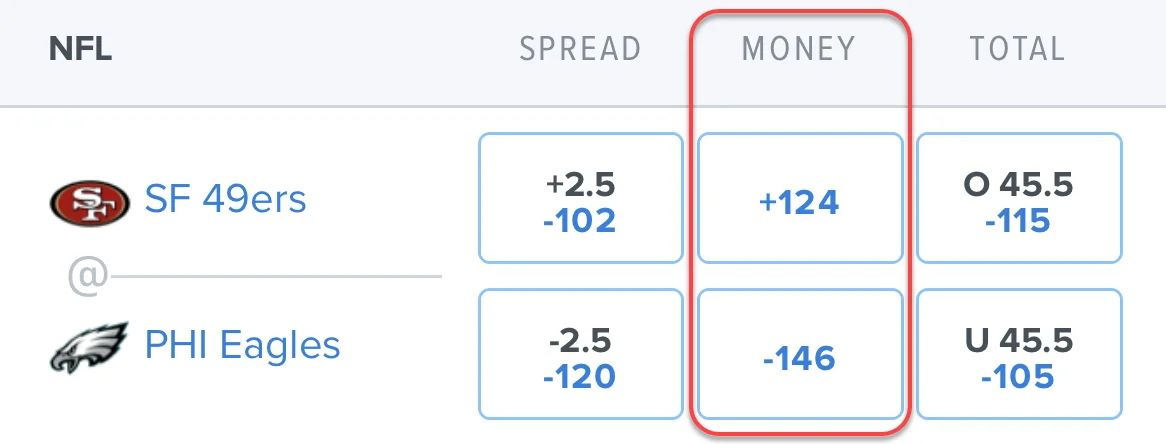
How to Read Moneyline Odds
Moneyline bets are a popular choice for both novice and experienced sports bettors due to their simplicity. But before placing a wager, understanding how to read and interpret moneyline odds is crucial. Here’s a breakdown to help you navigate the game.
The Fundamentals
- The Objective: You’re essentially predicting the winner of a specific game or event. Unlike point spreads, the final score or margin of victory is irrelevant.
- Odds & Payouts: These numbers, displayed with a plus sign (+) or minus sign (-), indicate the potential payout for each team. They reflect the implied probability of each outcome, with favorites having lower odds and underdogs having higher odds.
Decoding the Signs
- Favorites (Negative Odds): Represented by a minus sign (-), these odds show the amount you need to wager to win $100. For example, -150 means you’d wager $150 to win $100 if the favored team wins. The higher the negative number, the stronger the favorite and the less you win per dollar wagered.
- Underdogs (Positive Odds): Represented by a plus sign (+), these odds show the potential profit for a $100 wager. For instance, +200 means a $100 bet on the underdog could potentially return $200 if they win. The higher the positive number, the bigger the underdog and the larger the potential reward, but also the lower the chance of winning.
Understanding the Payout
- Negative Odds: To calculate your potential winnings, divide 100 by the absolute value of the negative odds and multiply the result by your wager amount. For example, with a -150 moneyline and a $20 wager, you’d win ($100 / 150) $20 = $13.33.
- Positive Odds: Simply multiply your wager amount by the positive odds to determine your potential total return if you win. For example, a $10 bet on a +200 underdog would potentially return $10 2 = $20.
Example
Imagine a game between the Sharks (-200) and the Dolphins (+180). The Sharks are favored, meaning you’d need to bet $200 to win $100 if they win. On the other hand, a $100 bet on the underdog Dolphins could potentially return $180 if they win.
Outcomes of Moneyline Bets
There are three primary outcomes for a moneyline bet:
- Win: This is the most desired outcome, where you correctly predict the winner of the game or event. If your chosen team/athlete wins, you receive the payout determined by the money line odds you wagered on.
- Loss: This occurs when your chosen team/athlete loses the game or event. In this case, you lose your entire wager.
- Push (Draw/Tie): This outcome is only possible in sports where draws are a possibility, like soccer or boxing. If the game or event ends in a draw, the bet is considered a “push.” This means you neither win nor lose your wager and receive a full refund of the amount you bet.
Here’s a table summarizing the outcomes:
| Outcome | Description | Example |
|---|---|---|
| Win | You correctly predict the winner. | You bet on the Sharks (-200) to win and they win. You receive your payout (e.g., $13.33 for a $20 wager). |
| Loss | Your chosen team/athlete loses. | You bet on the Dolphins (+180) to win and they lose. You lose your $100 wager. |
| Push | The game or event ends in a draw (applicable in some sports). | You bet on a soccer match ending in a draw and it does. You receive your wager amount back (e.g., $100 if you bet $100). |
Additional Notes:
- In some instances, sportsbooks may offer a “draw no bet” option for certain money line bets. This option removes the possibility of a push and only considers win or loss outcomes.
- Understanding the specific rules and regulations of the sport you’re betting on is crucial, as certain events (e.g., forfeits, disqualifications) might have different implications for moneyline bets depending on the sport and sportsbook.
Top North American Sports for Moneyline Betting
The diverse landscape of North American sports offers a treasure trove of options for placing moneyline bets. From the high-octane action of the National Football League (NFL) to the strategic depth of Major League Baseball (MLB), each sport presents unique characteristics that can appeal to various betting preferences. Here, we delve deeper into the top contenders for moneyline betting in North America, considering factors like popularity, betting volume, and potential appeal to bettors.
The Reigning King: The National Football League (NFL)
The NFL undoubtedly occupies the throne in the realm of sports betting popularity in North America. Its passionate fanbase, coupled with a season packed with high-stakes games, fuels a significant share of the total betting volume across the continent. The NFL’s dominance in this arena is further solidified by the staggering statistic of an estimated $16 billion wagered legally across the US during Super Bowl LVII in 2023, highlighting the immense interest it generates among bettors.
Fast-Paced Excitement: The National Basketball Association (NBA)
Beyond the NFL, the National Basketball Association (NBA) stands out for its fast-paced nature and unpredictable outcomes, making moneyline bets on this sport both exciting and potentially lucrative. The NBA boasts a dedicated fanbase across North America, translating into consistent and significant betting interest throughout the season. This widespread appeal is reflected in a 2023 report that revealed over 40 million Americans planned to wager on NBA games during the season, showcasing the sport’s significant presence in the betting landscape.
Strategic Depth and a Long Season: Major League Baseball (MLB)
Major League Baseball (MLB) offers a unique blend of strategic depth and individual player performance, adding an extra layer of complexity to moneyline betting considerations. This, in turn, can appeal to bettors who enjoy analyzing various factors beyond just the overall team strength. Additionally, MLB’s lengthy season, spanning from spring to fall, provides a prolonged window for placing moneyline bets throughout the year, catering to those who enjoy consistent betting opportunities. A 2023 survey indicated that 17% of American adults planned to bet on MLB games, demonstrating the sport’s continued relevance and appeal among bettors.
Rising Star: The National Hockey League (NHL)
While not yet at the level of the NFL or NBA, the National Hockey League (NHL) has been steadily gaining traction in terms of viewership and betting interest in recent years. This increasing popularity can be attributed, in part, to the NHL’s frequent close games and unexpected upsets, making moneyline bets on underdogs potentially more rewarding. The sport’s viewership experienced a notable 20% increase during the 2022-23 season, according to the NHL, which could signify a potential rise in betting popularity alongside its growing fanbase.
It’s crucial to remember that the “best” sport for moneyline bets ultimately boils down to individual preferences, knowledge of the sport, and risk tolerance. Regardless of the chosen sport, thorough research, a solid understanding of the odds, and responsible betting practices are always paramount for a successful and enjoyable betting experience.
Moneyline Bets vs Other Forms of Sports Betting
Moneyline bets stand as an excellent choice in sports betting, yet the diverse landscape of gambling offers a plethora of alternatives. In this brief analysis, we dissect the nuances of moneyline bets in contrast to other prevalent forms of sports betting, shedding light on their distinct characteristics and potential advantages.
Moneyline vs. Point Spread
- Focus: Moneyline bets revolve solely around predicting the winner, whereas point spreads introduce the element of the margin of victory.
- Payouts: Moneyline odds directly correlate with potential payouts, in contrast to point spreads where payouts hinge on whether the chosen team covers the spread.
- Complexity: The binary win/loss approach of moneyline bets generally makes them simpler to comprehend compared to the intricacies of point spreads.
- Suitability: Moneyline bets prove ideal for confidently forecasting winners, while point spreads cater to scenarios where the margin of victory remains uncertain.
Moneyline vs. Totals
- Focus: Moneyline bets zero in on determining the outright winner, while totals emphasize the cumulative score of both teams or individuals.
- Payouts: Moneyline odds dictate payouts for predicting the winner, while totals odds define payouts based on accurately forecasting whether the combined score surpasses or falls below a specified number.
- Complexity: Both moneyline and total bets are generally considered straightforward in terms of understanding.
- Suitability: Moneyline bets are apt for predicting winners, while totals bets find their niche in anticipating high or low-scoring outcomes.
Moneyline vs. Parlays
- Structure: Moneyline bets operate as single wagers, contrasting with parlays that amalgamate multiple bets into a unified ticket.
- Payouts: While money line bets yield a singular payout, parlays present the prospect of significantly larger payouts if all individual bets within the parlay emerge victorious.
- Risk: Moneyline bets carry a lower risk, as only one correct prediction is required, whereas parlays embody high-risk, high-reward scenarios.
- Suitability: Moneyline bets suit individual predictions, while parlays cater to confident forecasts across multiple events, offering heightened payout potential albeit with a greater risk of losing the entire wager.
Moneyline vs. Futures
- Timeline: Moneyline bets typically pertain to individual games or events, while futures bets extend over more extended periods, such as predicting the winner of a league or tournament.
- Odds: Moneyline odds adjust dynamically throughout the season, whereas futures odds are set well in advance and subject to changes based on team performance and external factors.
- Risk & Reward: Both moneyline and futures bets present varying levels of risk and reward contingent on the chosen options.
- Suitability: Moneyline bets align with shorter-term predictions, while futures bets find their strength in long-term prognostications, offering the potential for greater rewards at a commensurate increase in risk.
Moneyline betting is one of the simplest and easiest ways to make money from sports betting. However, how does it compare to other forms of sports betting? Here is a table explaining that.
| Feature | Moneyline | Point Spread | Totals | Parlays | Futures |
|---|---|---|---|---|---|
| Focus | Winner | Margin of victory | Combined score (over/under) | Multiple winning bets combined | Long-term outcome (e.g., champion) |
| Payout | Single payout based on odds | Payout based on covering the spread | Payout based on over/under prediction | Large payout if all bets win, otherwise lose entire wager | Payout based on odds at bet placement |
| Complexity | Relatively simple | Moderate complexity | Relatively simple | High complexity | Moderate complexity |
| Suitability | Confidently predicting winner | Uncertain margin of victory | Predicting high/low scoring games/events | Confident predictions on multiple events (high risk, high reward) | Long-term predictions (higher risk, higher potential reward) |
| Risk | Lower risk | Moderate risk | Moderate risk | High risk | Varies depending on the chosen outcome |
What Does a +200 Money Line Mean?
In sports betting, a +200 money line signifies several key details about a particular wager. Here’s what a +200 money line means.
- Underdog Team: The team associated with the +200 moneyline is considered the underdog in the matchup. This means they are generally less likely to win the game or event compared to their opponent.
- Potential Payout: The +200 represents the potential payout you would receive if you wager $100 and the underdog team wins the game. In this scenario, you would win $200 (your original $100 wager + $200 profit).
- Higher Risk, Higher Reward: The positive money line indicates a higher risk associated with the bet compared to a favorite with negative odds. However, a winning bet also offers a higher potential reward than a winning bet on a favorite.
- Example: Imagine the Kansas City Chiefs are playing another team, and the Chiefs have a money line of -150 (favored), while their opponent has a money line of +200 (underdog). If you bet $100 on the Chiefs (favored) to win and they win, you would win less than $100 (due to the negative odds). Conversely, if you bet $100 on the underdog team (with the +200 moneyline) and they win, you would win $200.
- Comparison to Other Odds: It’s important to compare moneyline odds across different sportsbooks as they can vary slightly. Additionally, the specific value of +200 is just one example, and you might encounter higher or lower positive money lines depending on the perceived underdog status of the team and the specific matchup.
What Does a Negative Moneyline Mean?
In the world of sports betting, a negative money line indicates a few key things about a particular wager:
- The Favorite’s Badge: First and foremost, a negative moneyline signifies that the team or athlete associated with that line is considered the favorite to win the game or event. Oddsmakers assign negative moneylines to teams they believe are more likely to emerge victorious based on various factors like recent performance, player statistics, and historical matchups.
- Decoding the Numbers: The negative value itself doesn’t directly represent the team’s chance of winning. Instead, it shows the amount you need to wager in order to win $100 if your chosen favorite wins. For instance, a moneyline of -150 means you would need to bet $150 to win a profit of $100 if the favored team wins the game. The higher the negative number, the stronger the favorite and consequently, the less you win per dollar wagered on them.
- Lower Payout, Higher Likelihood: The concept behind negative moneylines is essentially this: since the favorite is more likely to win, the potential payout is lower to balance the risk-reward dynamic for the bettor. While it might seem less exciting to win a smaller amount on a favorite compared to a potentially high return on an underdog, the increased likelihood of winning makes negative moneyline bets a popular choice for many bettors.
- Example in Action: Imagine the upcoming game between the mighty Dragons and the underdog Griffins. The Dragons have a moneyline of -200, while the Griffins have a positive moneyline (which we’ll discuss later). If you place a $150 bet on the Dragons (the favorite) to win with their -200 moneyline, here’s what happens:
- Win Scenario: If the Dragons win, you win your bet and collect your payout. The payout is calculated by dividing your winnings ($100) by the absolute value of the moneyline (200) and then multiplying that result by your original wager ($150). In this case, you’d win ($100 / 200) $150 = $75 profit (plus your original $150 wager, for a total return of $225).
- Loss Scenario: If the Griffins pull off an upset and win the game, you unfortunately lose your entire $150 wager.
Key Takeaways
- Negative money lines are for betting on the favorite.
- The higher the negative number, the stronger the favorite and the lower your potential payout.
- Negative money lines offer a lower potential return compared to positive moneylines (underdogs) but come with a higher chance of winning.
How Sportsbooks Rake in the Dough: The Magic of Moneyline Vigorish
Sportsbooks aren’t charities; their business model relies on turning a profit from wagers placed by bettors. While moneyline bets themselves might seem straightforward – you pick the winner, you win (or lose) – the secret sauce lies in how sportsbooks set the odds and implement a hidden fee called the “vigorish” (often shortened to “vig”). Here’s a breakdown of how sportsbooks make money from moneyline bets:
The Allure of Balanced Action
Imagine a perfect scenario for a sportsbook: an equal number of bets placed on both the favorite (negative moneyline) and the underdog (positive moneyline) in a matchup. Let’s say the favorite has a moneyline of -120 and the underdog has a +100 moneyline. This might seem fair to bettors, but the magic happens behind the scenes.
The Vigorish: A Hidden Tax
The vigorish, embedded within the moneyline odds themselves, is essentially a commission the sportsbook charges for taking your bet. It ensures they profit regardless of which team wins, as long as the total amount wagered on both sides is roughly equal.
Here’s how it works:
- Negative Moneylines Don’t Pay 1:1: A moneyline of -120 doesn’t mean a $120 wager wins you $120 profit. In reality, you’d need to wager $120 to win only $100 profit. That hidden $20 difference is the vigorish.
- Positive Moneylines Don’t Pay Enough: While a moneyline of +100 might seem like a straight-up double your-money win, it’s not quite that rosy. A $100 bet on the underdog with +100 odds would only win you $100 profit, not $200. The sportsbook keeps the additional $100 you wagered as part of the vigorish.
Balancing the Books
By setting the moneyline odds with a built-in vigorish, the sportsbook ensures that no matter which team wins and how much is wagered on each side (as long as the action is balanced), they will always profit from the difference between the total money wagered and the total payouts. Here is an example in Action:
Let’s revisit the scenario where the favorite has a -120 moneyline and the underdog has a +100 moneyline. Imagine bettors place a total of $1,200 on the favorite (meaning they wagered a combined $1,200) and $1,000 on the underdog.
- Payouts if Favorite Wins: If the favorite wins, the sportsbook needs to pay out $1,000 (total wagers on underdog) to losing underdog bettors. However, they collect the entire $1,200 wagered on the winning favorite. So, they keep the $200 difference (vigorish) as profit.
- Payouts if Underdog Wins: If the underdog pulls off an upset, the sportsbook must pay out $1,000 (total underdog wagers) at +100 odds, which means they pay a total of $2,000 (winnings + original wagers) to underdog bettors. However, they still collect the $1,200 wagered on the losing favorite. Here, they pocket the $800 difference (vigorish) as profit.
In essence, the moneyline odds act like a scale, with the vigorish tipping it slightly in the sportsbook’s favor.
Key Takeaways
- The vigorish is the sportsbook’s hidden commission embedded within moneyline odds.
- It ensures the sportsbook makes a profit regardless of which team wins, as long as the action is balanced.
- Negative moneylines require you to wager more than you win, while positive moneylines don’t pay out the full potential profit.
By understanding the vigorish and how it affects moneyline bets, you can become a more informed bettor and make smarter wagering decisions.
What is 3-Way Moneyline Betting?
Three-way moneyline betting, also known as three-way betting or outright betting, is a wagering option in sports betting where you predict the outright winner of a game or event, with three possible outcomes:
- Team A wins
- Team B wins
- The game ends in a draw or tie (applicable only in sports where draws are possible, like soccer)
Key Differences from Traditional Moneyline
- Traditional money line: Only focuses on predicting the winner, regardless of the margin of victory.
- Three-way moneyline: Considers all three possible outcomes, including a tie. This adds a layer of complexity and potential for higher payouts, especially for bets on draws, which typically have higher odds due to their less frequent occurrence.
Understanding the Odds
Each of the three outcomes in a three-way moneyline bet will have its associated odds, represented by either a plus (+) sign (underdog) or a minus (-) sign (favorite).
- Positive odds: Indicate the potential profit you would receive for a winning bet of $100. For example, +200 means you win $200 for a $100 bet on the winning team/outcome.
- Negative odds: Indicate the amount you need to wager to win $100. For example, -150 means you wager $150 to win a profit of $100 if your chosen team/outcome wins.
Example
Imagine an NFL game between the Tampa Bay Buccaneers (TB) and the Green Bay Packers (GB). The three-way moneyline odds might look like this:
- TB: -130 (favorite)
- GB: +110 (underdog)
- Tie: +800 (highly unlikely)
- If you bet $100 on TB (win) and they win, you would win $100 / 1.3 * 100 = $76.92 (profit) + your original $100 wager, for a total return of $176.92.
- If you bet $100 on GB (win) and they win, you would win $100 * 1.1 = $110 (profit) + your original $100 wager, for a total return of $210.
- It’s important to note that, unlike soccer, NFL games cannot end in a tie during regular play. The game would go into overtime if the score is tied at the end of regulation. However, some sportsbooks may offer a three-way money line option that includes a tie, but this represents the game ending in a tie after regulation, not factoring in potential overtime. Therefore, the odds of a tie in an NFL game would be very high (like +800 in this example) due to its extreme rarity.
Where is Three-way Moneyline Betting Used?
This type of betting is most commonly found in sports where draws are a possibility, such as:
- Soccer
- Boxing
- Mixed Martial Arts (MMA)
- Cricket
- American Football (NFL) in some sportsbooks (excluding overtime)
Three-way moneyline betting adds an element of strategy and potential for increased rewards compared to traditional moneyline bets. However, it also involves a higher degree of complexity and requires careful consideration of all three possible outcomes and their associated odds before placing a wager.
Why and How do Moneyline Odds Shift?
Moneyline odds are not static; they constantly fluctuate in response to various factors that can influence the perceived probability of each team winning. Here’s a breakdown of the key reasons why moneyline odds change:
Influx of Bets
- Shifting Public Perception: As more bets pour in on one side, the sportsbook might adjust the odds to balance the action. This means if a large sum of money is wagered on the favorite (negative moneyline), the sportsbook might increase the negative value (making the favorite less attractive) to encourage bets on the underdog and vice versa.
- Sharp Action: When a respected bettor (known as a “sharp”) places a significant wager on a particular team, it can signal valuable information to the sportsbook. If the sharp bets on the underdog, the sportsbook might shorten the underdog’s odds (making them less lucrative) to account for the increased chance of that team winning.
New Information
- Injuries and Suspensions: Unexpected injuries or suspensions to key players can significantly impact a team’s performance. If a star player gets injured, the sportsbook might adjust the odds in favor of the opposing team, reflecting the decreased chances of the injured team winning.
- Weather Conditions: Certain sports, like baseball and football, can be significantly affected by weather. If the forecast predicts heavy rain or strong winds, the sportsbook might adjust the odds to favor the team better equipped to handle those conditions.
Time Factor
- As the game approaches: As the game date nears, the odds might fluctuate based on any last-minute news, injury updates, or changes in betting patterns. Generally, the odds become more stable closer to the game time.
- Line Movement: The movement of the line refers to the changes in the moneyline odds over time. Tracking these movements can help experienced bettors identify potential betting opportunities based on where the line is headed.
Take note
- Sportsbooks use sophisticated algorithms and expert analysis to set and adjust moneyline odds.
- Understanding the reasons behind these changes can help you make informed betting decisions and potentially find value in the odds.
- It’s crucial to research, compare odds across different sportsbooks, and manage your bankroll responsibly before placing any bets.
FAQs About Moneyline in Betting
How does a money line bet differ from a point spread bet?
The key difference lies in the point spread involved. While moneyline wagers solely focus on who wins, point spreads factor in a handicap, giving the underdog a head start on the score (e.g., +7 points) or requiring the favorite to win by a certain margin (e.g., -3 points) for your bet to win.
Can I place a money line bet on any sporting event?
Money line markets are available for most major sporting events like football, basketball, baseball, and hockey. Multiple sportsbooks offer various betting options, including moneyline wagers, for these events.
Can I parlay a money line bet with other bets?
Yes, you can combine multiple moneyline bets (or other types of bets) into a single parlay bet. However, this increases the risk as all individual bets within the parlay need to win for you to receive a payout, which can be quite challenging.
Where can I place a money line bet?
You can place moneyline wagers at Las Vegas sportsbooks or online at multiple sportsbooks offering legal sports betting in your region. Remember to research and choose reputable and licensed sportsbooks before placing any bets.
Is a money line bet a good option for new bettors?
Yes, due to its straightforward nature, money line betting is often considered a good starting point for new bettors. It’s crucial to understand betting odds and choose wagers within your budget and risk tolerance.
Are there any bonus bets or promotions related to moneyline wagers?
Some sportsbooks might offer bonus bets or promotions specific to particular matchups or events, which could include enhanced moneyline prices. Always read the terms and conditions of any bonus offer before claiming it.
Can I place a money line bet on one team to win the Super Bowl?
While not technically a money line bet in the traditional sense, some sportsbooks offer future bets on which team will win outright the Super Bowl. These bets function similarly to moneyline wagers with specific money lines for each team, but they are placed well in advance of the event.
Do you have to bet $100 on the moneyline?
No, the $100 is a standard reference point for simplicity. You can bet any amount, and the potential payout is proportionate to your wager. For instance, a $50 moneyline bet with +200 odds could potentially yield a $100 profit.
When should I bet on the moneyline?
Moneyline bets are suitable when you are confident in predicting the outright winner of a game or event. They are particularly appealing when you believe the underdog has a good chance of winning or when point spreads seem uncertain.
Conclusion
Moneyline betting offers a straightforward and exciting way to wager on your favorite sports teams or athletes. By understanding the core concepts of favorites, underdogs, odds, and payouts, you can navigate the world of moneyline bets with confidence. Remember, responsible betting practices and thorough research are paramount for a successful and enjoyable betting experience.
This article has equipped you with the essential knowledge to embark on your moneyline betting journey. Utilize the insights gained here to analyze matchups, compare odds across different sportsbooks, and make informed decisions that align with your betting preferences and risk tolerance.
Whether you’re a seasoned sports enthusiast or a curious newcomer, moneyline betting offers a thrilling avenue to engage with the world of sports and potentially reap the rewards of your predictions. So, delve into the dynamic landscape of moneyline betting, and put your knowledge to the test!

